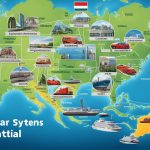Wondering where to live and work? Let’s compare Australia and Singapore to decide which country is correct for you.
Comparing living and working conditions in Australia and Singapore provides valuable information for people considering overseas relocation. Australia, recognized for its rich culture and extensive landscapes, offers an excellent quality of life with a focus on work-life balance. It attracts competent people due to its robust economy and welcoming immigration policy.
Conversely, Singapore is a vibrant city-state with a thriving economy and plentiful job possibilities. It does, however, have a higher cost of living and a faster-paced lifestyle. People can make educated decisions about their potential living and working place by researching aspects such as culture, cost of living, and job possibilities.
So why wait any longer? Let’s get straight to these factors:
- Economy
Australia Economy
Australia has a strong economy, ranking 13th in the world in terms of GDP. Australia’s GDP was roughly $1.33 trillion in 2023. This solid economic position is possibly due to the country’s abundant natural resources, growing services industry, and well-developed banking system. Mining, agriculture, education, and tourism significantly contribute to the GDP. For example, Australia is one of the world’s top exporters of resources such as iron ore and coal, which are critical to the country’s economic growth.
Singapore Economy
Despite its tiny size, Singapore is a worldwide economic powerhouse, routinely placing among the top GDP per capita countries. Singapore was placed 30th in the world in terms of total GDP, with a fantastic GDP of roughly $515 billion. Singapore’s financial stability can be attributed to its strategic position, excellent port infrastructure, and a flourishing finance and technology industry. The country is noted for its busy port, which is one of the busiest in the world, and acts as a regional center for international enterprises.
- Cost of living
Australia Cost of living
It’s vital to note that the cost of living in Australia varies substantially depending on where you reside.
Sydney and Melbourne, two of the most popular cities, for example, are more expensive. A one-bedroom apartment in the city center might cost between AUD 2,000 and AUD 3,000 monthly rent. Groceries, dining out, and transportation can all be expensive in comparison to other countries.
Nonetheless, it is worth noting that salaries in Australia are often more excellent in order to compensate for higher living expenditures. With a robust economy and various career options, you can balance these costs with a high salary.
Singapore Cost of living
Singapore, frequently regarded as a worldwide financial powerhouse, has a diverse cost of living scenario. While it is routinely ranked among the world’s most expensive cities, it also has superb infrastructure, healthcare, and education.
Rent in Singapore can be expensive, with a one-bedroom apartment in the city center costing between SGD 2,500 and SGD 4,500 per month. However, a well-functioning public transit infrastructure and lower taxes can assist to offset these expenditures.
Singapore’s strong pay packages, particularly in fields such as finance and technology, make it particularly appealing. Singapore’s increased earning potential might assist individuals in handling the high cost of living.
- Healthcare
Australia Healthcare
Medicare, Australia’s universal healthcare system, is well-known. Medicare provides free or subsidized medical services to Australian citizens and permanent residents, covering doctor visits and hospital treatment. Medicare is supported by the country’s taxation system, guaranteeing that everyone has equal access to healthcare. Private health insurance is also widely available in Australia, providing additional benefits such as reduced wait times for elective operations and a greater variety of healthcare providers.
The Australian healthcare system is well-known for providing extensive services and producing excellent health results. According to the World Index of Health Innovation, Australia’s healthcare system ranks 5th in the world in terms of performance, with an average life expectancy of 83 years.
Singapore Healthcare
The healthcare system in Singapore is a mixture of public and private services. The government plays an essential role in healthcare finance through programs like Medisave, MediShield, and Medifund, which aid residents in saving for healthcare bills, providing insurance coverage, and providing financial support to those in need. While public hospitals and clinics provide primary healthcare at a low cost, many Singaporeans prefer to obtain private health insurance for extra coverage and access to private healthcare facilities.
Singapore’s healthcare system is well-known for its effectiveness and high quality. According to the World Index of Health Care Innovation, Singapore ranks tenth in the world for healthcare system performance, with a life expectancy of roughly 84 years.
- Education
Australia Education
Australia has a world-class education system that is well-known for its high standards and various offers. The country is home to many prestigious universities, including the University of Melbourne and the Australian National University. Australian colleges attract students from all over the world because they focus significantly on research and innovation.
The education system in Australia provides a diverse range of courses and degrees, encompassing vocational training, bachelor’s, master’s, and doctorate programs. It is well-known for its adaptability, which allows students to adjust their educational route to their job objectives. According to Student Statistics figures, over 600,000 international students were enrolled in educational institutions in 2022.
Singapore Education
Singapore’s education system is renowned for its high standards and regularity. Due to high standards and a significant emphasis on science, technology, engineering, and mathematics (STEM) topics, the country ranks among the top worldwide in education tests. Singapore is home to world-class universities such as the National University of Singapore (NUS) and Nanyang Technological University (NTU).
Students in Singapore follow a well-structured curriculum with a high focus on critical thinking and problem-solving abilities. The country’s dedication to education is reflected in its government spending, with education receiving a sizable share of the national budget. Singapore’s education spending was around 13.82% of its GDP in 2022, demonstrating the country’s commitment to delivering high-quality education.
- Work hours
Australia Work hours
In Australia, a typical workweek is 38 hours long, spread out across five days, Monday through Friday. The typical workday begins between 8:00 a.m. and 9:00 a.m. and ends around 5:00 p.m. or 6:00 p.m. While these are basic principles, actual working hours can vary based on the sector and employer. Some organizations, for example, can have flexible work arrangements that allow employees to modify their start and end times within appropriate bounds.
In Australia, a lunch break often lasts 30 minutes to an hour, allowing employees to rest and recharge during the workday. Many employees carry their lunch to work, while others eat in adjacent cafés or restaurants. Furthermore, some firms provide standard rooms where employees can socialize and relax.
Singapore Work hours
Singapore, like Australia, has a regular workweek of 44 hours spread over five days. However, it is crucial to remember that in some industries or specialized job categories, work hours can go above the typical 44 hours. Workdays often begin at 9:00 a.m. and conclude at 6:00 p.m. or 7:00 p.m., which varies based on the firm and role.
Lunch breaks in Singapore are usually one hour long, giving employees plenty of time to eat and relax. Singaporeans frequently take advantage of this chance to sample local cuisine at hawker centers or to dine at adjacent restaurants and food courts. The lunch break is a time to eat, socialize with coworkers, and recharge for the rest of the day.
- Work leaves
Australia Work leaves
The Fair Work Act 2009 oversees employment conditions in Australia, including yearly leave benefits. Full-time employees are typically entitled to four weeks (20 days) of paid annual leave every year, with part-time employees accruing leave on a pro-rata basis. Some firms may include supplementary leave in their employment contracts.
The extensive yearly leave rules in Australia help to an excellent work-life balance. Employees can take lengthy vacations, spend quality time with their families, or pursue hobbies. This method improves employee well-being and work satisfaction.
Singapore Work leaves
Singapore, famous for its vibrant business climate, provides a unique viewpoint on work leaves. According to the Singapore Employment Act, employees in Singapore enjoy a minimum of seven days of annual leave in their first year of employment, which gradually climbs to 14 days after three years of service. The employer can choose to provide more time off.
While Singapore has fewer annual vacation days than Australia, it makes up for it with a strong work culture that promotes efficiency and production. The shorter period of annual leave encourages employees to use their time effectively, which adds to Singapore’s successful economic performance.
- Salary
Australia Salary
Australia is well-known for its flourishing economy and excellent living standards. In Australia, the average annual pay is roughly $68,900. However, it is crucial to remember that incomes can vary greatly depending on criteria such as geography, career, and experience.
For example, incomes tend to be higher because of the greater cost of living in big cities like Sydney and Melbourne. Professionals in finance, information technology, and healthcare sectors can earn significantly more than the national average in these locations.
Australia also has a low unemployment rate, which helps the country’s economic stability. According to the most recent available statistics, Australia’s unemployment rate is roughly 3.7%, suggesting a solid work market.
Singapore Salary
Singapore, a worldwide financial center, is well-known for its thriving economy. In Singapore, the average annual pay is around $70,000. Similar to Australia, incomes in Singapore can vary greatly depending on criteria such as industry and experience.
For example, professionals in Singapore’s financial industry might make much more than the national average. According to the latest data, Singapore also has a low unemployment rate, which now stands at around 1.9%. The low unemployment rate reflects the city-state’s robust job market and business-friendly atmosphere.
Australia has a high standard of living, an excellent work-life balance, and a robust economy with various industries. However, it comes with a variable cost of living, especially in big cities. The healthcare and education systems are first-rate, and work hours are acceptable, allowing for a healthy work-life balance.
Conversely, Singapore has a growing economy, competitive pay, and a strategic position. While the cost of living is more significant, the efficient public services, strong employment market, and shorter yearly leave periods contribute to a distinct work culture that places a premium on productivity.
















